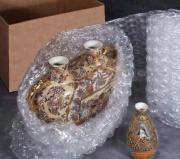Difference between revisions of "Bubble wrap"
m (Text replace - "== Authority ==" to "== Sources Checked for Data in Record ==") |
|||
| Line 2: | Line 2: | ||
== Description == | == Description == | ||
| − | + | Introduced in 1960 as a trademark of Sealed Air Corporation, Bubble Wrap was formed from a double layer of plastic film containing sealed bubbles, or air pockets, between the layers. The bubbles provide cushioning and are often used to provide some shock and vibration isolation Bubble wrap is typically made from [[polyethylene]] films, but some brands may be composed of [[polyvinylidene chloride]] or [[polyvinyl chloride]]. The permeability of the film can result in deflation of the bubbles overtime. Some versions, such as Aircap@ [Sealed Air] and Polycap@ [Ipsind] have and additional layer of nylon that prolongs the lifetime of the bubble. Anti-static versions are also available. | |
== Synonyms and Related Terms == | == Synonyms and Related Terms == | ||
| − | bubble-wrap; Artifact bubble wrap; bubble pack; air fill; Luftpolsterfolie (Deut.) | + | Bubble Wrap@; Bubblewrap; bubble-wrap; Artifact bubble wrap; bubble pack; bubble paper; air fill; Air Cap; Polycap; Luftpolsterfolie (Deut.) |
| + | |||
| + | == Forms and Sizes == | ||
| + | Bubble wrap is usually sold as rolls with widths up to 72” wide. Bubble sizes can range from 1/4” to 2“ diameter; typically 3/16”, 5/16” and ½”. Perforations optional ( e.g. every 12”). | ||
| + | |||
| + | ==Additional Information== | ||
| + | Bubble Wrap history: https://web.archive.org/web/20100923074021/http://www.bubblewrapturns50today.info/bubble_wrap_facts.pdf | ||
| + | |||
| + | Sealed Air products: http://www.sealedairprotects.com/eu/en/products/bubblewrap/bubble_wrap.aspx | ||
== Sources Checked for Data in Record == | == Sources Checked for Data in Record == | ||
| + | |||
| + | * PACCIN | ||
* Marjorie Shelley, ''The Care and Handling of Art Objects'', The Metropolitan Museum, New York, 1987 | * Marjorie Shelley, ''The Care and Handling of Art Objects'', The Metropolitan Museum, New York, 1987 | ||
Revision as of 13:13, 3 November 2018
Description
Introduced in 1960 as a trademark of Sealed Air Corporation, Bubble Wrap was formed from a double layer of plastic film containing sealed bubbles, or air pockets, between the layers. The bubbles provide cushioning and are often used to provide some shock and vibration isolation Bubble wrap is typically made from Polyethylene films, but some brands may be composed of Polyvinylidene chloride or Polyvinyl chloride. The permeability of the film can result in deflation of the bubbles overtime. Some versions, such as Aircap@ [Sealed Air] and Polycap@ [Ipsind] have and additional layer of nylon that prolongs the lifetime of the bubble. Anti-static versions are also available.
Synonyms and Related Terms
Bubble Wrap@; Bubblewrap; bubble-wrap; Artifact bubble wrap; bubble pack; bubble paper; air fill; Air Cap; Polycap; Luftpolsterfolie (Deut.)
Forms and Sizes
Bubble wrap is usually sold as rolls with widths up to 72” wide. Bubble sizes can range from 1/4” to 2“ diameter; typically 3/16”, 5/16” and ½”. Perforations optional ( e.g. every 12”).
Additional Information
Bubble Wrap history: https://web.archive.org/web/20100923074021/http://www.bubblewrapturns50today.info/bubble_wrap_facts.pdf
Sealed Air products: http://www.sealedairprotects.com/eu/en/products/bubblewrap/bubble_wrap.aspx
Sources Checked for Data in Record
- PACCIN
- Marjorie Shelley, The Care and Handling of Art Objects, The Metropolitan Museum, New York, 1987
- Pam Hatchfield, Pollutants in the Museum Environment, Archetype Press, London, 2002
- Random House, Webster's Encyclopedic Unabridged Dictionary of the English Language, Grammercy Book, New York, 1997
- The American Heritage Dictionary or Encarta, via Microsoft Bookshelf 98, Microsoft Corp., 1998
